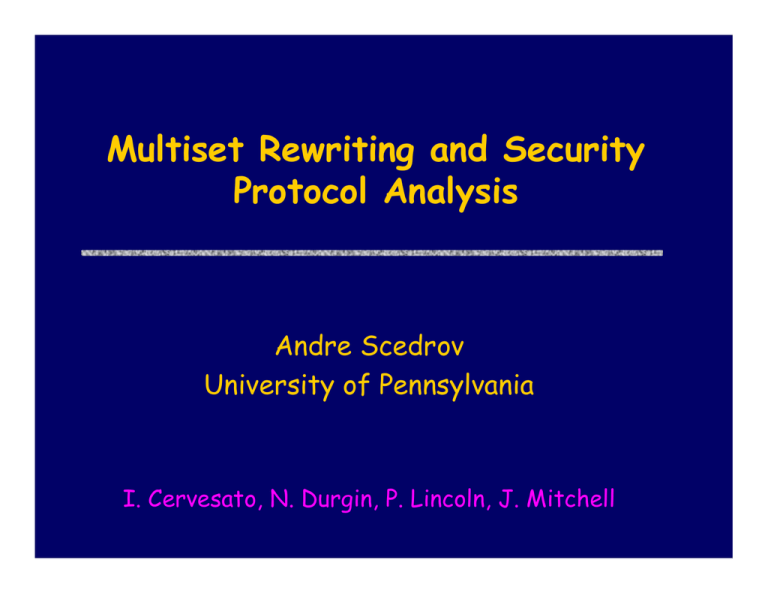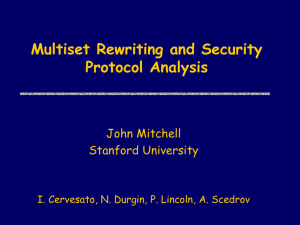Multiset Rewriting and Security Protocol Analysis Andre Scedrov University of Pennsylvania
advertisement

Multiset Rewriting and Security
Protocol Analysis
Andre Scedrov
University of Pennsylvania
I. Cervesato, N. Durgin, P. Lincoln, J. Mitchell
Outline
Protocol security
Analysis methods
Multiset rewriting with ∃
• Rewrite formalism with “choose new value”
• Protocol modeling within this framework
Decision problems
Applications of the MSR framework
• Kerberos 5
[Butler, Cervesato, Jaggard, Sc.]
• Contract-signing protocols
[Chadha, Kanovich, Sc.]
[Chadha, Mitchell, Sc., Shmatikov]
Protocol Security
Cryptographic Protocol
• Program distributed over network
• Use cryptography to achieve goal
Attacker
• Read, intercept, replace messages, and
remember their contents
Correctness
• Attacker cannot learn protected secret
or cause incorrect protocol completion
Run of protocol
Initiate
A
Respond
B
Attacker
C
D
Correct if no security violation in any run
Protocol Analysis Methods
Non-formal approaches
(useful, but no tools…)
• Some crypto-based proofs [Bellare, Rogaway]
• Communicating Turing Machines
[Canetti]
BAN and related logics
• Axiomatic semantics of protocol steps
Methods based on operational semantics
• Intruder model derived from Dolev-Yao
• Protocol gives rise to set of traces
– Denotation of protocol = set of runs involving arbitrary
number of principals plus intruder
Example projects and tools
Prove protocol correct
• Paulson’s “Inductive method”, others in HOL, PVS,
• MITRE - Strand spaces
• Process calculus: Abadi-Gordon, Gordon-Jeffrey
Search using symbolic representation of states
• Meadows: NRL Analyzer, Millen: CAPSL
Exhaustive finite-state analysis
• FDR, based on CSP
[Lowe, Roscoe, Schneider, …]
• Murphi, CASPER, CAPSL, …
All depend on behavior of protocol in presence of attack
Sophistication of attacks
Low
High
Protocol analysis spectrum
Hand proofs
Poly-time calculus
Multiset rewriting with ∃
Spi-calculus
Strands
Paulson
NRL
Bolignano
BAN logic
FDR
Low
Protocol complexity
High
Murϕ
A notation for inf-state systems
Linear Logic
Proof search
(∀∃∧∨¬)
(Horn clause)
Multiset
rewriting
Finite Automata
Process
Calculus
• Many previous models are buried in tools
• Define common model in tool-independent formalism
Notation commonly found in literature
A → B : { A, Noncea }Kb
B → A : { Noncea, Nonceb }Ka
A → B : { Nonceb }Kb
• The notation describes protocol traces
• Does not
– specify initial conditions
– define response to arbitrary messages
– characterize possible behaviors of attacker
Rewriting Notation
Non-deterministic infinite-state systems
Facts
F ::= P(t1, …, tn)
t ::= x | c | f(t1, …, tn)
Multi-sorted
first-order
atomic formulas
States { F1, ..., Fn }
• Multiset of facts
– Includes network messages, private state
– Intruder will see messages, not private state
Rewrite rules
Transition
• F1, …, Fk → ∃x1 … ∃xm. G1, … , Gn
What this means
• If F1, …, Fk in state σ, then a next state σ’ has
– Facts F1, …, Fk removed
– G1, … , Gn added, with x1 … xm replaced by new symbols
– Other facts in state σ carry over to σ’
• Free variables in rule universally quantified
Note
• Pattern matching in F1, …, Fk can invert functions
• Linear Logic: F1⊗…⊗Fk o ∃x1 … ∃xm(G1⊗…⊗Gn)
Common Intruder Model
Derived from Dolev-Yao model
• Adversary is nondeterministic process
• Adversary can
–
–
–
–
Block network traffic
Read any message, decompose into parts
Decrypt if key is known to adversary
Insert new message from data it has observed
• Adversary cannot
– Gain partial knowledge
– Guess part of a key
– Perform statistical tests, …
Formalize Intruder Model
Intercept, decompose and remember messages
N1(x) → M(x)
N3(x) → M(x)
N2(x,y) → M(x), M(y)
Decrypt if key is known
M(enc(k,x)), M(k) → M(x)
Compose and send messages from “known” data
M(x) → N1(x), M(x)
M(x), M(y) → N2(x,y), M(x), M(y)
M(x) → N3(x), M(x)
Generate new data as needed
∃x. M(x)
Highly nondeterministic, same for any protocol
Protocol theory
Initialization theory
• Bounded theory that “precedes” protocol run
• Example: ∃ key. Principal(key)
Role generation theory
• Principal(key) → A0(key), Principal(key)
• Principal(key) → B0(key), Principal(key)
Role theory
• Finite ordered list of rules
Ai(…), Nj(…) → ∃… Ak(…), Nl(x)
where i<k, j<l
• Can also have persistent predicates on left/right
Two-phase intruder theory
Avoid pointless looping by intruder
• M(x), M(y) → N(x,y), M(x), M(y)
• N (x,y) → M(x), M(y)
Phase 1: Decomposition
Phase 2: Composition
Thesis: MSR Model is accurate
Captures “Dolev-Yao-Needham-Millen-Meadows- …” model
• MSR defines set of traces protocol and attacker
• Connections with approach in other formalisms
Useful for protocol analysis
• Errors shown by model are errors in protocol
• If no error appears, then no attack can be carried
out using only the actions allowed by the model
Complexity results using MSR
Bounded #
of roles
Intruder ≠, =
with ∃
= only
Intruder ≠, =
w/o ∃
= only
Bounded
use of ∃
Unbounded
use of ∃
??
NP –
complete
DExp –
time
Undecidable
All: Finite number of different roles, each role of finite length, bounded message size
Key insight: existential quantification (∃) captures cryptographic
nonce; main source of complexity
[Durgin, Lincoln, Mitchell, Scedrov]
Lower bounds from Horn clauses
Bounded #
of roles
Intruder ≠, =
with ∃
= only
Intruder ≠, =
w/o ∃
= only
Bounded
# of ∃
Unbounded
# of ∃
??
NP-complete:
Provable by Dexptime:
boundedDatalog
length proof
Undecidable:
Datalog + ∃
All: Finite number of different roles, each role of finite length, bounded message size
Need to show that hard instances of Horn clause inference can be
be represented in the restricted form of a security protocol
[Durgin, Lincoln, Mitchell, Scedrov]
Additional decidable cases
Bounded role instances, unbounded msg size
•
•
•
•
Huima 99: decidable
Amadio, Lugiez: NP w/ atomic keys
Rusinowitch, Turuani: NP-complete, composite keys
Other studies, e.g., Kusters: unbounded # data fields
Constraint systems
• Cortier, Comon: Limited equality test
• Millen, Shmatikov: Finite-length runs
All: bound number of role instances
Using MSR for protocol analysis
Extensions and general properties
• Add dependent types and subsorting
• DY intruder is most powerful attacker
[C]
[C]
Relate to other models
• Strand space model
• Linear logic provability
[CDLMS]
[CDKS]
Prove protocols correct
• Kerberos 5
• Contract signing
[Butler, Cervesato, Jaggard, Sc.]
[Chadha, Kanovich, Sc.]
[Chadha, Mitchell, Sc., Shmatikov]
Kerberos Authentication Protocol
Protocol goals
• Repeatedly authenticate a client to multiple
servers
• Minimize use of client’s long term key(s)
• Does not guard against DOS attacks
Kerberos 4 - 1989
Kerberos 5
• Specified in RFC 1510 (1993)
• Subsequent revisions by working group
A real world protocol
• Windows 2000 (RFC 1510 + extensions)
• User login, file access, printing, etc.
Previous formal analysis
Kerberos 4
• Analyzed using inductive approach
(Bella & Paulson)
Kerberos 5
• Simplified version analyzed with Murφ
(Mitchell, Mitchell, & Stern)
[Butler, Cervesato, Jaggard, Scedrov]
Kerberos 5 Analysis: Goals
Give precise statement and formal analysis
of a real world protocol
• Find a real world protocol – Kerberos 5
• Pick favorite formalization method - MSR
Identify and formalize protocol goals
Give proofs of achieved protocol goals
• Gain experience in reasoning with MSR
Note any anomalous behavior
• Suggest possible fixes, test these
Kerberos 5
Client C wants ticket for end server S
• Tickets are encrypted – unreadable by C
C first obtains long term (e.g., 1 day)
ticket from a Kerberos Authentication
Server K
• Makes use of C’s long term key
C then obtains short term (e.g., 5 min.)
ticket from a Ticket Granting Server T
• Based on long term ticket from K
• C sends this ticket to S
Protocol Messages
Please give me ticket for T
C
Ticket for C to give to T
C
Ticket from K, one for S?
C
Ticket for C to give to S
C
C
C
Ticket from T
Confirmation (optional)
K
K
T
T
S
S
Overview of Results
Formalized Kerberos 5 at different levels of
detail
Observed anomalous behavior
• Some properties of Kerberos 4 do not hold for
Kerberos 5
• Proved authentication properties that do hold for
Kerberos 5
Proofs of properties which do hold
• Methods adapted from Schneider
Interactions with Kerberos working group
Rank and Corank
Inspired by work of Schneider
Define functions on MSR facts
• k-Rank – encryptions by k
– Data origin authentication
• E-Corank – level of protection by keys in E
– Secrecy
Proofs
• State desired property
• Find applicable (co)rank functions
• Determine effect of MSR rules on these functions
(End glimpse of Kerberos 5 analysis)
Conclusions
Thesis
• Protocol analysis requires precise
definition of possible runs under attack
• Multiset rewriting with ∃
–
–
–
–
Provides natural, usable formalism
Captures set of runs
Exhibits uniformity of DY attacker
Related to linear logic, other protocol notations
• Can use proof-theoretic results from LL
• Can approximate MSR model by finite-state analysis
Conclusions
Results
• Decision problems
– NP-complete with bounded role instances
– Dexp-time complete with bounded nonces (∃)
– Undecidable even if everything else bounded
• Applications
– Metatheory
• Two attackers no better than one
• Correctness of model checking optimizations
– Protocol analysis
• Contract signing, Kerberos v5
Future directions
Specification language
• MSR defines traces, execution tree
• Need to specify correctness formally
Programming language?
• Separate commands done from those that remain
• Distinguish local knowledge from global state
Quantification over protocols
• Every protocol satisfying ϕ also satisfies ψ.
• Composition: Properties of Compose(A, B) from
properties of A and B
Multiset Rewriting and Security
Protocol Analysis
Andre Scedrov
University of Pennsylvania
